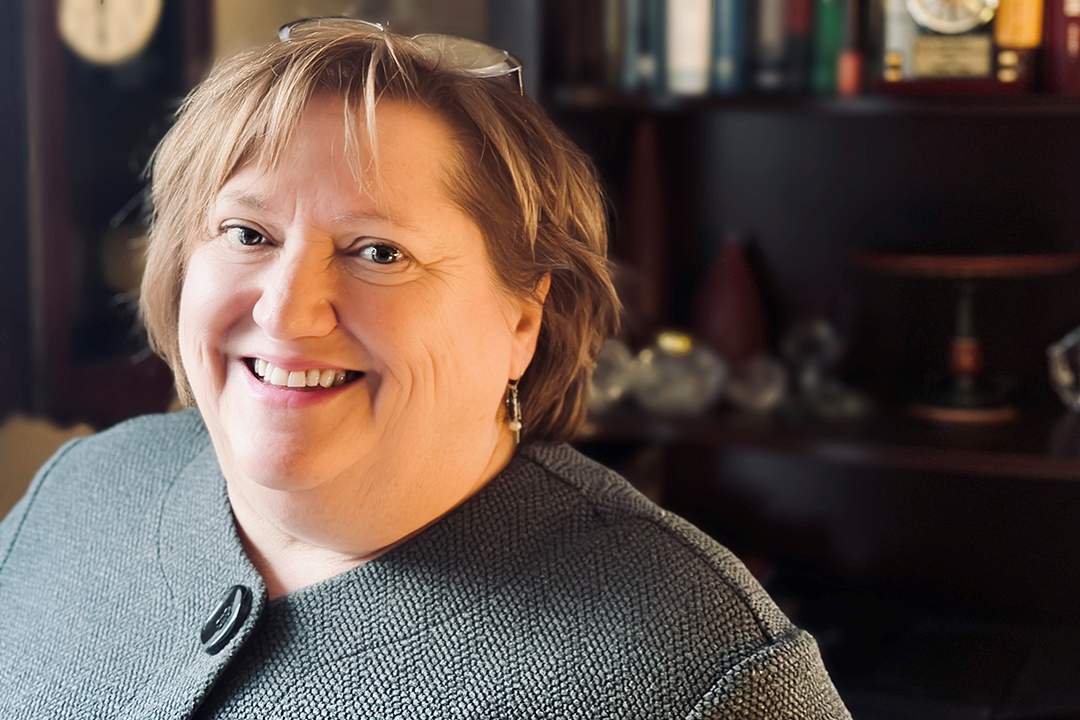
Inhale, Exhale, Repair: Dr. Valerie Verge
Dr. Valerie Verge (PhD) was in her early twenties when she landed her first job, doing neuroscience research and she loved it. But 43 years ago, her research journey began to take a twist.
By researchers under the scopeListen to all episodes of the Researchers Under the Scope podcast.
Researchers Under the Scope is produced by the Office of the Vice-Dean Research in the College of Medicine.
"I developed an allergy to rats and mice,” she said. “I was using a box of Kleenex a day.”
She reluctantly had to admit that research might not be her career path and spent her evenings earning a ‘back-up plan’ degree in computer programming at McGill. She refused to give up laboratory work, and went on with her colleagues to code and create an in-house computerized image analysis system that was not readily available commercially or affordable.
“That was huge back then,” she said. “It came in very, very handy because we were able to integrate images on our microscope with computers and quantitatively analyze them.”
As her allergies gradually lessened, Verge stayed in the lab and earned her PhD in the Department of Neurology and Neurosurgery at McGill in 1990, then moved to the Karolinska Institute in Stockholm for post-doctoral studies. By 1992, she followed her heart to the prairies, and found ‘wonderful opportunities’ for research at the University of Saskatchewan’s (USask) College of Medicine and soon after in a new USask multiple sclerosis (MS) focused research centre in Saskatoon City Hospital.
Today, she’s a professor of anatomy, physiology and pharmacology, and the director of the Cameco MS Neuroscience Research Centre, with expertise converging on a singular goal — finding innovative ways to repair the nervous system.
Her recent peripheral nerve repair collaboration with Dr. Ming Chan from the University of Alberta Department of Medicine and Dr. Gillian Muir (DVM, PhD), dean of the USask Western College of Veterinary Medicine explores acute intermittent hypoxia (AIH) This non-invasive therapy involves breathing controlled alternating cycles of regular air and air with reduced oxygen levels.
"It sounds horrible! But it’s not like having a stroke, where you can have zero oxygen,” said Verge. “This is more like just taking it down by a percentage to a level that induces a beneficial stress response.”
The rationale behind AIH lies in its ability to trigger repair responses. By subjecting the body to a mild, controlled stressor, the therapy aims to activate repair mechanisms that can be beneficial for nervous system repair. Verge's work involves investigating the impact of AIH on repairing peripheral nerves, outside of the brain and spinal cord and more recently, extending this therapy to investigate repair and neuroprotection in a model of multiple sclerosis.
In a female mouse model of progressive multiple sclerosis, Verge said graduate student Nataliya Tokarska observed an 80 per cent reduction in inflammation levels after just once daily treatment with the AIH protocol for one week
“They’re supposed to only get worse. Even two weeks after ending treatment, they’re still showing improvement,” said Verge, noting regions with lesions transitioned to a state of ‘advanced’ myelin repair; axons were being remyelinated and the immune response was dramatically decreased and shifted to a pro-repair state.
“It’s an extremely robust repair response like I’ve never seen in my 43 years of doing research.”
Verge said the technique has already helped patients with spinal cord injuries. In humans it does not raise their blood pressure or heart rate or induce memory loss.
Unlike invasive procedures, such as electrical nerve stimulation (ES), the entire body is exposed to AIH. Verge and her team are now building on previous ES findings, showing intermittent low oxygen therapy behaves in a similar favourable manner repairing damaged and severed nerves in animal models.
Grants from the Canadian Institutes of Health Research (CIHR) and MS Canada allow the research team to transition from pre-clinical rat work to human trials in carpal tunnel syndrome. Verge is hoping to work toward the same trials for patients with multiple sclerosis. This marks a crucial step toward validating the efficacy of AIH in repairing the nervous system.
“It’s a pleasure to see things come full circle,” said Verge, who said her role now is to inspire and share insight with the next generation of neuroscientists.
“We’re very, very hopeful for the future.”
